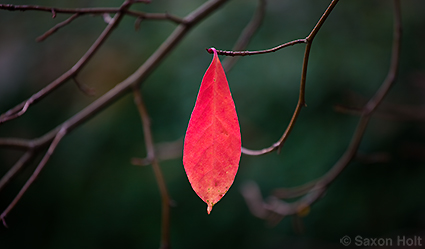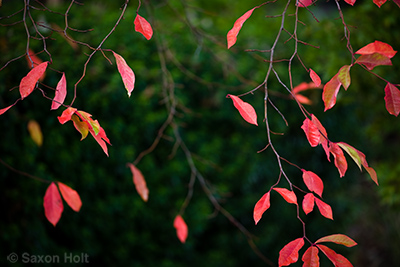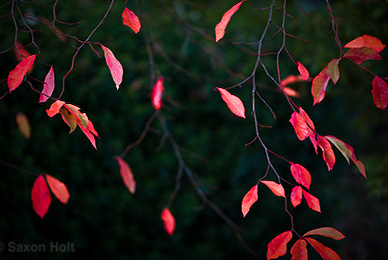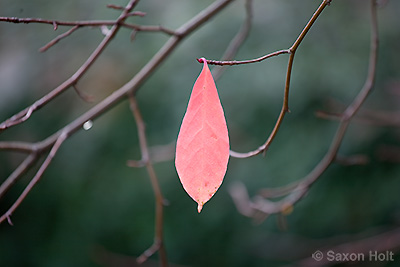
Red Tupelo Leaf Centered
When I went looking for fall color in my garden, I did not expect to see a red hole into another universe. In fact, I did realize it was there until I contemplated my original picture (to follow at the end).
The great master of black and white photography, Ansel Adams learned to pre-visualize his photographs. He manipulated his images with filters even before he exposed them, and then worked magic in the darkroom to bring out what he wanted his audience to see. He would have loved Photoshop.
The camera always lies – or rather, as I say every time I use that phrase, the photographer uses the camera to tell a story the way the photographer wants it to be told. If you have a story to tell before you use the camera, an intention to communicate something, your camera (and your post production “darkroom” tools) can say far more than words.
I went looking to make a rich moody picture of orangy-red leaves of the Tupelo tree (Nyssa sylvatica) by my front door. We don’t get much native autumn color here in California, so I have planted some of my favorites near to the house. Last year about this time, inspired by fall color of Gingko and Oakleaf Hydrangea, I wrote a post about seeing a photo. This year, already too late to get a good shot of the wonderful red color of my Tupleo in full color, I never-the-less felt there was a memory to be preserved, a mood to convey, a picture to be had in the simple symmetry of the few remaining leaves.

In the gloomy shade of the north facing front of my house, I used a telephoto lens to isolate a composition of leaves and branches against a green hedge. Color is a vital element of this composition, red strokes dancing on a canvas, and I thought of Ansel Adams, previsualizing what I wanted to remember.
For the Tupelo vision I wanted to remember, the splashes of color needed to be a key to the composition and they needed to be enhanced to accent their position. I also slightly cropped, down to the top of the hedge.

Digital manipulation is easy to understand and used by almost every professional photographer I know. Sometimes subtle, sometimes overdone, often imperceptible to the viewer, but never-the-less a vital tool for creating publication quality photographs.
Next I crop a bit more, add another splash of color (in the center), and make the background of the garden a bit darker and cooler. (The new leaf is not added digitally – it is a different photo – I added the leaf to the branch as I “worked” the original composition.)

tupelo final
I may work this photo some more, but it is close to what I want to remember and what I thought I saw in my front yard. What I did not expect to see when I began this process, was the hole in the universe.
I refer back to the first photo, where the composition of the red leaf in the dead center now draws us into another world, a crack in the garden. Stare at it for just a moment. Only once color becomes the sole focus of the photo are we drawn into it and wonder what lies beyond the picture.
This is how that photo started:

